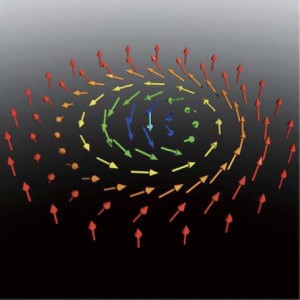Advance towards high density/low energy devices Theoretical basis of skyrmion manipulation

A Todai-RIKEN research team has explored theoretically the current-driven dynamics of a skyrmion ? a particle in magnet ? in constricted geometries such as memory devices or circuits by numerical simulations. The skyrmion was originally proposed as a model of a stable particle in nuclear physics, and is realized in magnet as a swirling nano-scale spin texture. This particle is regarded as a promising candidate for an information carrier in next-generation magnetic memories. For this purpose, the manipulation of its dynamics is a most important issue. In particular, the study of current-driven dynamics in constricted geometries is indispensable for the development of devices using skyrmions. The research team has performed a large scale numerical simulation of the differential equation tracing the time-evolution of the magnetic structures, and found that the dynamics of a skyrmion in constricted geometries is totally different from that in free space and is subject to the influences of dissipation and impurities. Additionally, at the edge of the circuit, the skyrmion disappears when the current density is above a critical value, and skyrmions can be created very simply by applying current at a notch structure in the substrate ferromagnetic material.

© Naoto Nagaosa, Schematic picture of a skyrmion: a skyrmion is a swirling spin texture where the spins in the perimeter point up, point down at the core, and are winding in the intermediate region.
These results will provide the theoretical basis for the design of memories and logic circuits using skyrmions, and have been published in online Nature Nanotechnology on Sept. 9, 2013. This research has been supported by Grant-in-Aids for Scientific Research (S)(No.24224009)from the Ministry of Education, Culture, Sports, Science and Technology (MEXT) of Japan, and by Funding Program for World-Leading Innovative R&D on Science and Technology (FIRST Program) “Quantum Science of Strong Correlation”.
Paper
Junichi Iwasaki, Masahito Machizuki, & Naoto Nagaosa,
“Current-induced skyrmion dynamics in constricted geometries”,
Nature Nanotechnology Online Edition: 2013/9/9 (Japan time), doi: 10.1038/NNANO.2013.176.
Article link
Links
Graduate School of Engineering
Department of Applied Physics, Graduate School of Engineering
Nagaosa Lab, Department of Applied Physics, Graduate School of Engineering






